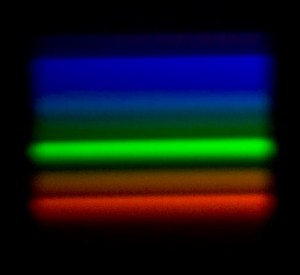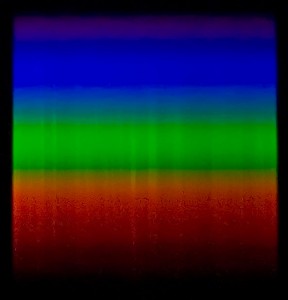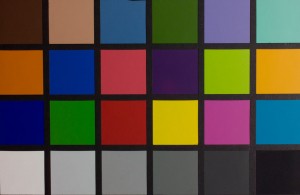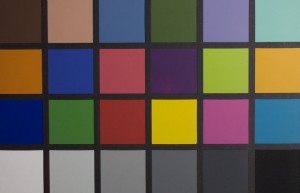I have written elsewhere about fluorescent lights for photography. I didn’t say anything complimentary there, and I don’t intend to say much that is nice in this blog. So if you really love the new compact fluorescent lights as studio lights, it might be best to stop now. Still, the results of my tests were somewhat less dire that I had anticipated.
I was finally able to borrow one of these lights (a Top Lighting PB-85 120v 85 watt) so that I could run tests. I certainly didn’t want to buy one. I did several tests: first I used my spectrometer to look at the color distribution of the light, that is look at the light spread into a rainbow. My spectrometer is made from cardboard, a couple of razor blades and a small piece of diffraction grating. It is not a tremendously accurate device. It was not designed to be used with a camera. Still I am including pictures of daylight and of the fluorescent tube. You can see that daylight is continuous, smooth. The fluorescent has big bright lines and big dark lines, so no continuous spectrum. So the nature of this light is very, very different from daylight.

Fluorescent Spectrum, notice how the spectrum is banded rather than continuous

Sunligth Spectrum, it is smoother in the spectrometer.
<p><P>
In my second test I made a picture of a Macbeth Color Chart with strobe light and the fluorescent light. The color of the two shots was very different, so I would not want to use the fluorescent light with my strobe. However when both shots were white balanced, in the computer, the shots were very similar. Really the fluorescent tube was a closer match than I would have expected, after the white balance. Please keep in mind that white balance will not enable to correct a shot for two different light sources.

Fluorescent version of the Color Checker, white balanced.

Strobe version of the Color Checker, white balanced.
<p>
In the third test I made 10 shots at a shutter speed of 1/180 to see if the light would be consistent on all the shots. I did not expect this to go well. Fluorescent tubes are supposed to vary with the cycling of alternating current electricity. In this country the power cycles 60 times a second. So 1/180 should be only part of a cycle. In this shot the color did not vary by as much as 1%, really quite impressive. Since the shots all looked the same, I am not including them.
Finally I compared the overall quantity of light to a 600 watt Smith Victor quartz light. The quartz light was 8 times more powerful than the fluorescent light. Although I could use an array of these lights to increase power, I could not get the power and hard light effect that I can get from quartz lights.
On the whole the light performed better with color than I had anticipated. However the unusual spectrum leaves me suspicious that there will be problems in the real world, especially with fabrics. Certainly the low power disappoints me, but if your camera performs well at high ISO levels, this may be less of a problem for you.
Thanks, John
Please check out my classes
An Introduction to Photographic Lighting
I have really enjoyied reading your well written article. It looks like you spend a lot of effort and time on your blog. I have bookmarked it and I am looking forward to reading new articles. Keep up the good work!
Comment by Ava — June 27, 2011 @ 5:00 am